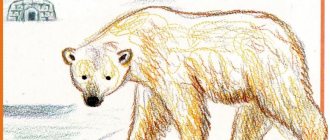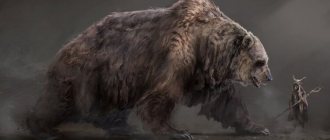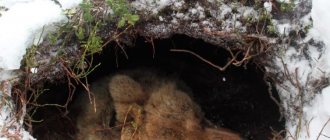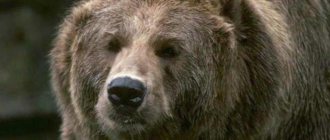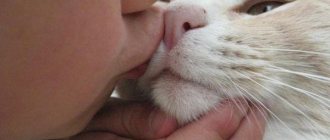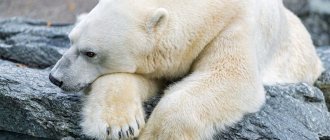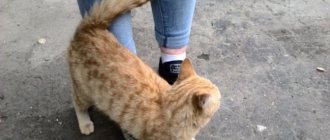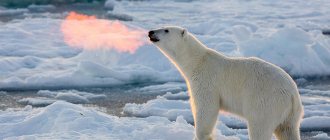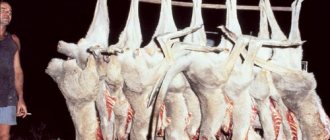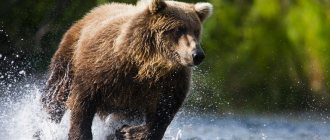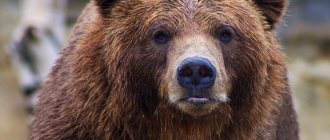The king of the Arctic deserts and eternal ice of the Arctic Ocean, the largest and most dangerous predator in the Arctic is the polar bear. Its habitat extends from the border of the tundra and arctic deserts to 88º north latitude. In the scientific world it is known as Ursus maritimus - the sea bear. The indigenous population of the Arctic knows the polar bear, it is an important part of folklore, art, mythology and magical rituals (such as initiation). The Chukchi call it Umka, the Eskimos - Nanuk, the Nenets - Yavvy, the Yakuts - Uryungege, the Pomors - Oshkuy.
Polar bears have lived in the Arctic for hundreds of thousands of years - the formation of a separate species occurred about 600 thousand years ago. But the Arctic bear we know is a descendant of a hybrid that came from crossing an ancient polar bear with a brown relative, which confirms that the polar species has a small percentage of genes characteristic of brown bears. However, polar and brown bears remain sufficiently genetically similar for “interracial marriages” to produce fertile offspring called grolar, or polar grizzly bears.
Polar bears reproduce quite slowly - after puberty at 4-8 years, a female bear gives birth to 1-3 cubs every 2-3 years. With a maximum lifespan of 25-30 years, this is 10-15 new individuals. However, up to 40-70% of cubs die in the first year of life - they are threatened by adult males, the need for long swims (the subcutaneous fat of the cubs is not developed enough), and poachers.
Why are there polar bears in the Arctic?
White color is generally characteristic of Arctic animals, and polar bears wear luxurious snow-white fur coats all year round. Why white? The most obvious answer to this question is camouflage. To successfully hunt against the backdrop of polar ice, it must successfully blend into the surrounding landscape.
But there are other reasons, for example, thermoregulation. Arctic animals live in regions with extremely low insolation, and the pigment melanin, which is also responsible for the color of animal fur, serves as an additional obstacle to the penetration of ultraviolet radiation. The skin, deprived of pigment, better transmits UV rays to the bear’s skin - no longer white, but black. Saturated with melanin, it easily absorbs ultraviolet radiation transmitted by wool, using it for heating and other processes. This creates an ideal “mechanism” that makes it possible to make maximum use of the weak insolation in the Arctic regions.
By the way, speaking of color, polar bear hairs are not white. They lack pigmentation, that is, color. In addition, they are hollow inside (this is also characteristic of the animal world of the Arctic regions, and is found, for example, in reindeer). This structure of the hair has better thermal insulation properties; in addition, the internal cavity of the hair is uneven, and light, reflected at different angles, gives the illusion of a white skin color. The fur is covered with a layer of sebum, allowing the bear to literally come out of the water unscathed, which is very important, because a polar bear in the Arctic is often forced to swim in order to hunt, or move from one ice field to another. The polar bear is an excellent swimmer; it moves in water at a speed of more than 6 km/h, can spend several minutes underwater, and the maximum recorded duration of a polar bear's swim was 685 km.
Influence of optical phenomena
The polar bear's fur is translucent, but due to the properties of the protective hairs, which are involved in creating the optical effect, this animal's fur appears white. From an optical point of view, the reason why a polar bear appears white is due to the effect of light on the animal's hair.
Interesting: The most dangerous bears - list, names, descriptions, photos and videos
Luminescence
Exposure to light causes a reaction known as luminescence.
When sunlight hits a polar bear's fur, some of that light becomes trapped in the fur. This light energy is reflected inside the hollow part of the hairs, causing a reaction that is the emission of light - luminescence. This happens every time a beam of light comes into contact with an animal's fur.
Luminescence is accelerated by light-scattering particles in the hairs, which destroy the light beam. When light hits a light-scattering particle, it splits into more rays that move in different directions. Light scattering particles are found both on the inner surface of the hairs and on the outer surface. The scattering of light causes more white color to appear and be further emitted by the animal's hair. Thus, the bear's translucent fur reflects sunlight. This is the reason why polar bears are especially bright in direct sunlight. The brighter the lighting, the more light is reflected by the polar bear's translucent fur.
Salt particles
Sea salt particles
Polar bears spend a lot of time in water, which explains the Latin name for these members of the bear family, ursus maritimus, which means “sea bear.” Polar bears collect salt particles while swimming or staying near salty sea water. Salt particles along the rough surface of the wool also act as light scattering particles, which increase the number of light rays and enhance luminescence.
Ultraviolet light
Ultraviolet light in the optical spectrum
When the sun shines on a polar bear, ultraviolet light along the protective hairs travels down to their base and penetrates the dark skin of the animal. When ultraviolet light hits the skin, it causes a whitish color due to fluorescence (the ability to release absorbed energy as cool light radiation). Fluorescence is a type of luminescence. Thus, ultraviolet radiation also causes the bear's fur to turn white.
Interesting fact: Ultraviolet rays, which are transmitted through translucent hairs, give the polar bear's fur its insulating properties.
Keratin
Keratin is a common natural protein found in skin, nails and hair. Similar to humans, bear hairs contain keratin. The protein molecules of keratin give off a whitish color, which further contributes to the appearance of white fur in the bear.
Interesting: Why is the Arctic warmer than Antarctica?
What does a polar bear eat in the Arctic?
The polar bear's diet depends on its habitat and body characteristics. Ideally adapted to harsh polar winters and long swims in cold water, it preys primarily on marine wildlife on land, ice and water.
He motionlessly lies in wait for ringed seals, bearded seals and walruses near the ice hole, throwing them onto the ice with a blow of his powerful paw, or sneaks up on animals on land while resting. In the water, bears can compete in agility and strength with beluga whales (Arctic whales), narwhals, and can catch fish, although this is not the bear’s primary interest. Polar bears also eat eggs, chicks, and young animals, which are much easier to catch than an adult. They do not disdain carrion - the corpses of sea animals and fish washed ashore. However, they will never touch the meat of representatives of their own species.
Whenever possible, the polar bear feeds very selectively - it eats the skin and fat of a caught seal or walrus, eats the rest only if it is very hungry; what it does not eat, it usually leaves for scavengers - birds and animals, which often accompany the “owner”, feeding on the remains of his meals . Berries and moss are also included in the polar bear's diet, but they are not included in its diet so often.
Currently, due to climate change, what the polar bear is used to eating often becomes inaccessible to it, then the bear switches to hunting Arctic land animals and birds (deer, lemming, goose), and raids warehouses and garbage dumps in Arctic villages. In the Canadian city of Churchill, a prison has even been built to house “recidivists” who disturb the peace of the city’s residents.
Bear hibernation
A bear's winter hibernation can last up to 200 days. In preparation for it, bears actively stock up on fat in the fall, and this is critically important for the bear. Those bears that have not managed to gain sufficient fat reserves cannot hibernate and, as a result, turn into connecting rod bears (they also become connecting rod bears due to the bear awakening too early after hibernation). Connecting bears are very dangerous animals (including for humans), attacking everything they come across in the forest. Usually connecting rod bears die from hunger, cold, or a hunter's bullet.
As for the state of ordinary bears hibernating in their secluded den, what is happening to them is somewhat reminiscent of suspended animation - the clubfoot’s pulse during hibernation decreases from the usual 55 beats per minute to 9 beats per minute. The level of metabolism (metabolism) in the bear's body decreases by 53%. At this time, bears, of course, do not eat, drink, or defecate; all their life processes seem to be paused. The exact mechanism of how bears actually hibernate is to this day the subject of scientific research by zoologists.
Polar bears live in the Arctic or Antarctica
Not only schoolchildren, but also adults are often confused about this issue. The distribution range of polar bears is limited to the Arctic. Even if the bears managed to overcome the distance from one pole to the other, they would hardly be able to survive in the Antarctic latitudes. There the temperature is lower, the thickness of the ice is hundreds of meters (in the Arctic - about a meter), which excludes the possibility of the favorite method of hunting sea life near an ice hole or crack. The fauna of Antarctica is also not adapted to the appearance of such a predator. In addition, this would put many species at risk of destruction - for example, penguins, which thrive in Antarctic latitudes and do not live in the Arctic.
Predators of the North Pole
The polar or polar bear is the largest predatory mammal that lives on the surface of the earth (second only to the elephant seal). He is the closest relative of the brown bear and belongs to the bear family. In nature, there are about fifteen species of polar bear, and the total number of animals is about twenty-five thousand.
You can meet these animals in the subpolar latitudes of the northern hemisphere, starting from Newfinland and ending at 88° N. sh., and they live on ice floating in the Arctic off the coast of Eurasia and America, so they can only be classified as terrestrial inhabitants only conditionally.
If you think about the natural zone in which polar bears live, you might be surprised: they are the only large predators in the Arctic, ideally adapted for normal existence in polar latitudes. For example, during snow storms they dig holes in the snowdrifts, lie down in them and, without going anywhere, wait out the elements.
Koalas are the original representatives of the living world of Australia88984.81
The size and weight of these animals largely depend on their place of residence: the smallest animals according to description live on Spitsbergen, while the largest ones live in the Bering Sea. The average height of a bear at the withers reaches about one and a half meters, while the weight of males significantly exceeds the weight of females:
- The weight of males ranges from 400 to 680 kg, length - about three meters (the weight of large lions and tigers does not exceed 400 kg);
- The weight of females ranges from 200 to 270 kg, the length is about two meters.
According to the description, the polar bear differs from other representatives of its species by its greater weight, powerful sloping shoulders, flat head and longer neck.
There is fur on the soles of the paws, which allows the animal not to slip and freeze. There is a membrane between the toes, and the structure of the paws allows polar bears to swim gracefully, gracefully and quickly. Large curved claws are not only capable of holding even strong prey, but also allow it to easily move on slippery ice and climb over blocks.
It is noteworthy that these animals are quite capable of reaching speeds of up to 10 km/h and swimming about 160 km without stopping. They are also very good divers and can stay underwater for about two minutes.
The polar bear does not freeze thanks to a thick, about 10 cm, layer of subcutaneous fat on the back, back of the body and hips, as well as very warm fur, which retains the heat generated. The predator's fur is very thick and dense; it not only reliably retains heat, but also protects the animal's body from getting wet, and its white color makes it possible to camouflage perfectly.
The teeth of polar bears are also noteworthy: in cross-section, they form annual circles of two cement layers. The tooth is tightly attached to the jaw, as the root of the teeth is connected to it by a layer of cement that grows throughout the bear's life. At different times of the year, the layer grows differently and seems to consist of two parts: the winter layer is thinner than the summer layer, which is located above it, and the older the animal, the smaller the distance between the rings.
This is interesting: Why does a giraffe have a blue tongue?
Offspring
A she-bear gives birth for the first time no earlier than four years of age (and sometimes the first birth occurs at eight). She gives birth to no more than three cubs every two to three years. The mating season usually lasts from March to June, with one female followed by about three to four males, who constantly fight with each other, and adults can even attack and kill cubs. Polar bears can interbreed with brown bears, resulting in offspring that, unlike many other animal species, are also capable of reproducing.
The female bears prepare to give birth in October, starting to dig dens near the coast in the snow drifts. To do this, females often gather in one place; for example, about two hundred dens appear annually on Wrangel Island. They do not settle in them immediately, but in mid-November, and hibernate until April. Pregnancy lasts up to 250 days and the cubs appear blind and deaf, usually in the middle or end of the Arctic winter (the eyes open after a month).
Despite the impressive size of an adult, newly born babies are not much longer than a rat, and their weight ranges from 450 to 750 grams. When the cubs are about three months old and gain weight, they begin to gradually leave the den with the mother bear, gradually switching to a wandering lifestyle. The cubs live with their mother for three years, and until they are one and a half years old, she feeds them with milk, while at the same time feeding them seal blubber. The mortality rate among babies is quite high and ranges from 10 to 30%.
Bear breeding
Despite the fact that bears are monogamous animals, their pairings are usually short-lived and break up after a couple of years. The mating season for bears can occur at different times (depending on the species), but what is interesting is that mother bears always give birth to their cubs in the winter, right during hibernation and leave the den with cubs. The pregnancy of a female bear, depending on the species, lasts from 180 to 250 days. From 1 to 4 cubs are usually born at a time.
Little bear cubs are born without fur, without teeth and with closed eyes. At first, they are completely dependent on their mother, feeding on her milk, then they begin to quickly gain weight and grow hair until they turn into full-fledged adult bears.
